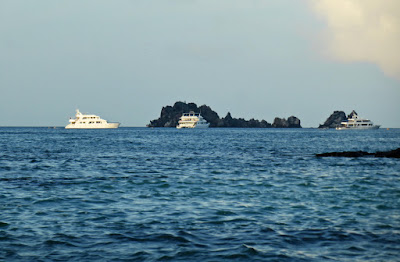How it looks from above ...
The early morning kayakers returned in time for a landing on the Darwin Bay beach.
They reboarded through a zodiac intermediary.
Most of the rim of the bay is composed of rocky cliffs,
but the promised sandy beach (top of photo)
gave us access.
It was a wet landing, but not bad.
We immediately encountered nazca boobies. They suffer from lesser popularity than their blue-footed and red-footed cousins, even though the black-and-white plumage is striking in its own right.
Birds were flying everywhere above the cliffs,
and, although the breeding season was wearing on, many were still attempting to attract mates, such as this male frigate bird with his inflatable sack.
A red-footed booby! The face and beak were colorful too.
A juvenile waited nearby.
This one has eyes shut. Glare from the sun, or just resting?
It could be incubating an egg, as with this one a few minutes later.
This booby was attempting to maneuver a very large stick into its nest, but it never did fit, and was dropped.
Then we encountered a field mostly of frigate birds.
Lots of red lanterns dotted the landscape, many screeching their mating cry.
A closeup of the sack. Parts of it are feathered!
We inspected the tidal waters. (My camera tends to create vertical stripes when panning a panoramic shot if the lighting changes strongly across the scene.)
Joan found a nearly intact sally lightfoot exoskeleton.
A couple of sea lions were snoozing.
As we waited for the zodiac back to the Islander, I admired these marine iguanas. As usual, they were utterly unconcerned about us.
Then it was time for our fifth and final snorkeling session, along the cliffs on the west side of the bay. I felt like I'd graduated from a five-step program, and now had it all: cycling socks to protect my toes from the fins, a snorkel that fit the mask properly, no need for a flotation vest, the underwater camera in my hand, and the ability to snorkel where there was some wave and current action.
The wave and current action stirred up sediment and other floating bits, so photography was difficult. Some saw a hammerhead shark, but he swam away into the murk before I could get close. I'll give you one highly processed (cropping, contrast adjustment, etc.) photo of a pufferfish, but that will be all.
In the afternoon we'll zodiac over to the east side of the caldera, climb up Prince Philip's Steps, and explore the wildlife there, including owls. (Prince Philip visited the Galapagos in 1965 and 1981.) Next post!










































































